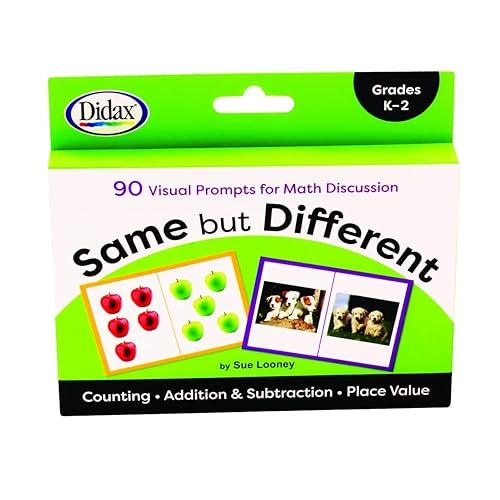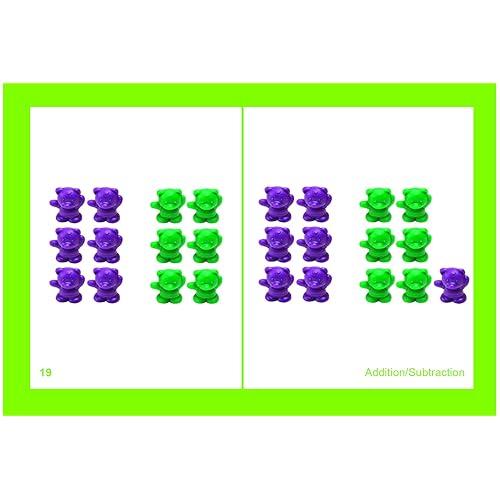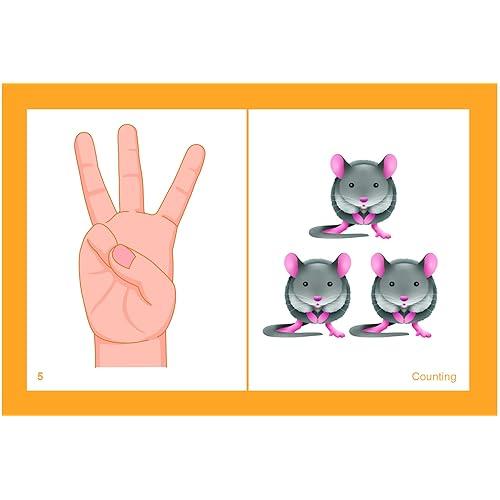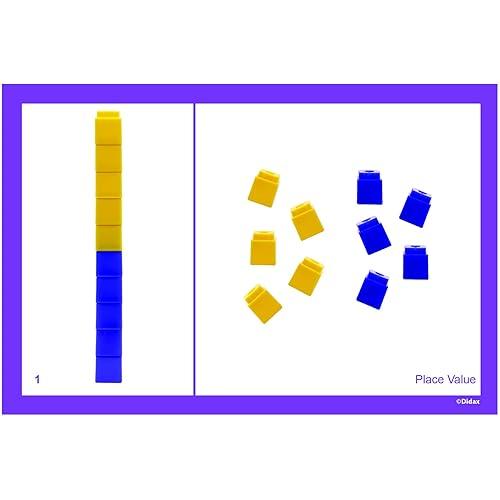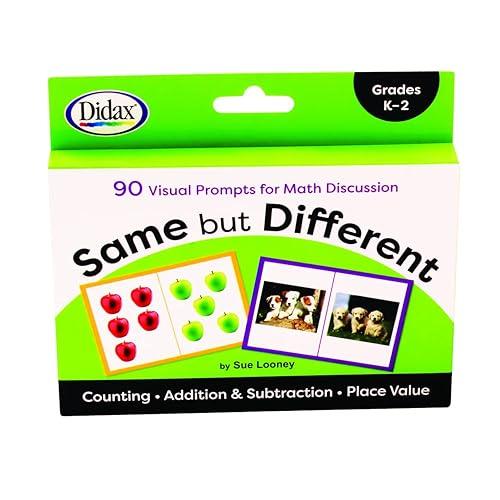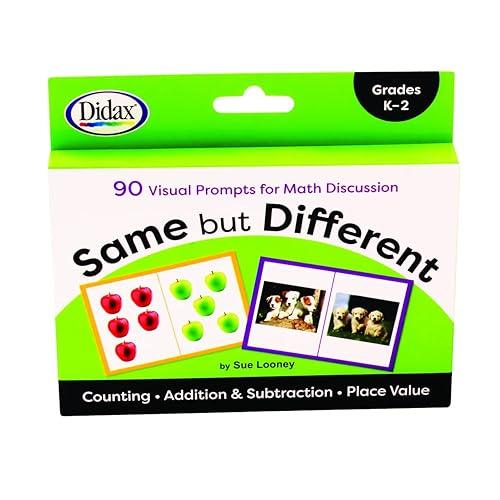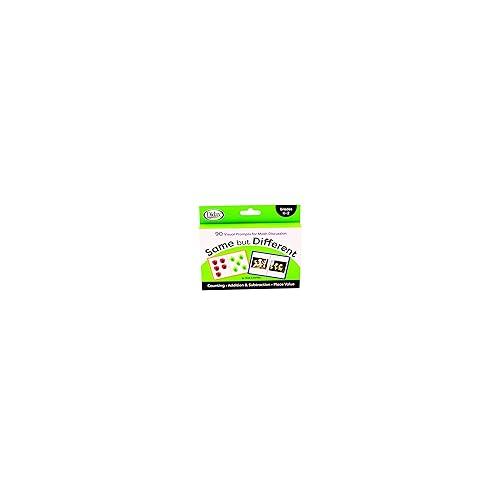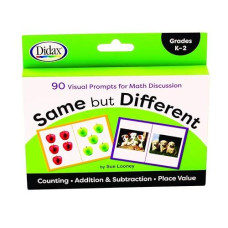Didax Same But Different Cards, Grades K-2, Multicolor
US Delivery Time: 3-5 Business Days.
Outside US Delivery Time: 8-12 Business Days.
Unlock the potential of young minds with the Didax Comparison Cards, designed to foster engaging mathematical discussions in early education. This set of 92 full-color cards captivates children’s interest through vibrant photographs and illustrations, making learning fun and interactive. - Each card measures 4 inches by 6 inches, perfectly sized for little hands and easy handling. - Covers three essential math domains: Counting, Addition and Subtraction, and Place Value, catering to Grades K-2. - Multi-colored design stimulates visual learning and keeps children engaged in the learning process. - Crafted by Didax, a trusted name in educational resources, ensuring high quality and durability. - Ideal for classroom settings, homeschooling, or supplemental learning, promoting collaborative and independent math skills. Enhance your teaching toolkit with these versatile and practical comparison cards that not only aid in skill development but also inspire a love for mathematics in young learners. Perfect for educators looking to create a dynamic learning environment.
Unlock the Power of Mathematical Conversations with Didax Colorful Comparison Cards
Transform your classroom into a vibrant hub of mathematical engagement with the Didax Colorful Comparison Cards. This exceptional set of 92 full-color cards is designed to captivate young learners and foster deep mathematical discussions. Perfect for Grades K-2, these cards utilize photographs, illustrations, and equations to prompt children to ask, "What is the same? What is different?"—a question that unlocks their critical thinking skills and enhances their understanding of mathematical concepts.
- Dynamic Learning Experience: Each card features a content-rich image comparison, encouraging students to explore mathematical ideas through visual stimuli.
- Versatile Usage: Ideal for whole-class instruction, small-group activities, or learning centers, these cards can easily be integrated into various teaching strategies.
- Comprehensive Content: The set includes 30 cards each from three key domains: Counting, Addition & Subtraction, and Place Value, along with two blank cards for personalized creations.
- Optimal Size: Each card measures a convenient 4" x 6", making them easy for little hands to handle and perfect for interactive learning.
- Durable Material: Crafted from laminated cardstock, these cards are built to withstand the rigors of classroom use while maintaining their vibrant colors and clarity.
Key Benefits:
- Encourages collaborative learning and peer discussions, fostering a supportive educational environment.
- Promotes conceptual understanding by linking visual comparisons to mathematical principles.
- Enhances engagement and motivation among students, making math an exciting subject to explore.
In real-world applications, these cards can be utilized in various educational settings. Teachers can display them during whole-class instruction to introduce new concepts or use them in centers where students can independently explore mathematical relationships. Small groups can engage in guided discussions, using the cards to spark dialogue and enhance comprehension. The inclusion of blank cards allows for creative expression, giving students the opportunity to create their own comparisons, thus reinforcing their learning experience.
As a multi-colored product, the Didax Colorful Comparison Cards add an aesthetic appeal to any classroom environment. The medium-sized cards are easy to store and transport, making them a practical choice for educators on the go. The durable laminated cardstock ensures longevity, allowing teachers to use these resources year after year.
Invest in the Didax Colorful Comparison Cards today and watch as your students embark on an exciting journey of mathematical exploration and discovery. Harness the power of visual learning and discussions to lay a strong foundation for their future success in mathematics.
 Warning - California Proposition 65
Warning - California Proposition 65 This product may contain chemicals known to the State of California to cause cancer, birth defects, or other reproductive harm.
Reviews (0)
Product FAQs
Q: What age group is this product suitable for?
Ans: This product is designed for students in Grades K-2, making it ideal for young learners in their early mathematical education.
Q: How many cards are included in the set?
Ans: The set includes a total of 92 cards, with 30 cards dedicated to each of the three mathematical domains: Counting, Addition & Subtraction, and Place Value, plus two blank cards for custom images.
Q: What materials are the cards made from?
Ans: The cards are made from laminated cardstock, ensuring durability and longevity for repeated classroom use.
Q: How can I use these cards in the classroom?
Ans: These cards can be used for whole-class instruction, set up in learning centers, or utilized for small-group instruction to facilitate dynamic mathematical discussions.
Q: What are the benefits of using these cards in math education?
Ans: The cards promote powerful mathematical conversations by encouraging students to explore similarities and differences, enhancing their conceptual understanding and connections between mathematical ideas.
Q: What are the dimensions of each card?
Ans: Each card measures 4 inches by 6 inches, making them a manageable size for young children to handle and interact with.
Q: Can these cards be used for independent learning?
Ans: Yes, these cards can be used for independent learning as well, allowing students to explore mathematical concepts at their own pace while engaging with visual comparisons.
Q: Are there any specific teaching strategies recommended for using these cards?
Ans: Teachers can use questioning strategies such as "What is the same? What is different?" to guide discussions and deepen students' understanding of mathematical concepts through visual comparisons.

